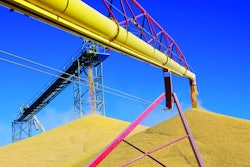In the overnight session the grains bounced with corn up 3 ¼ cents, soybeans were up 7 ¼ cents and wheat trading 10 ½ cents higher going into the morning pause. This morning's trade session should be supported by a nice export sale of 105,000 metric tons of old crop corn sold to unknown destinations.
Soybeans sold off sharply yesterday after the USDA revised yield and harvested acreage higher, lifting production by 11 million bushels. Ending stocks held steady after the USDA raised the 14/15 export sales expectations. However, traders looked at the 410 million bushels of U.S ending stocks as bearish after expecting to see a 17 million bushel revision lower in yesterday’s report.
U.S production wasn't the only place ending stocks increased. Brazilian soybean production was also revised higher by 1.5 million metric tons which helped lift global ending stocks by .9 million metric tons. With the current quality of the South American crop, and a continuation of the existing precipitation profile, we could begin to see more revisions higher in South American production over the next month which would weigh heavily on the market. With the South American crop expected to reach the peak of harvest in late February I would expect to see weaker prices over the next couple months.
In Brazil, showers are expected to cover central and northwest part of the growing region which will continue to improve the crop development. The northeastern part of Brazil is still the driest region. In Argentina, rains over the weekend helped provide relief to fields after experiencing some hot and dry weather over the last week. In the overnight more rains are expected throughout central Argentina.
Corn prices were mostly stable following the report after yield was slashed to 171 bushels per acre and harvested acres were left unchanged. However, despite the decreased production, quarterly grain stocks were larger than expected revealing weaker than expected feed usage. Ending stocks were revised 121 million bushels lower providing a positive surprise for bulls. With a bullish revision in supply behind us, and demand weaker than expected in this round of reports, I am concerned prices will not be able to make new highs in the rally that began back in October. We will need to see a strong increase in demand to be the backbone behind any further rally, especially with no foreseeable threat in South American production.








